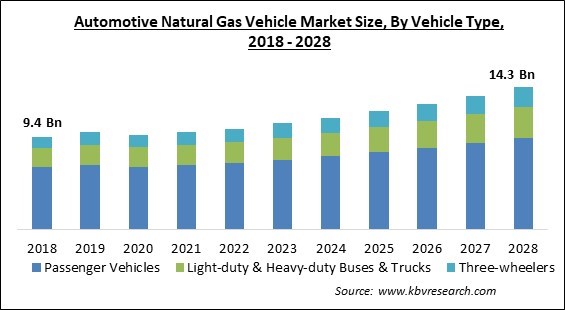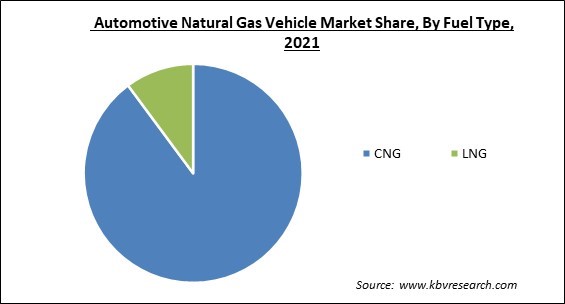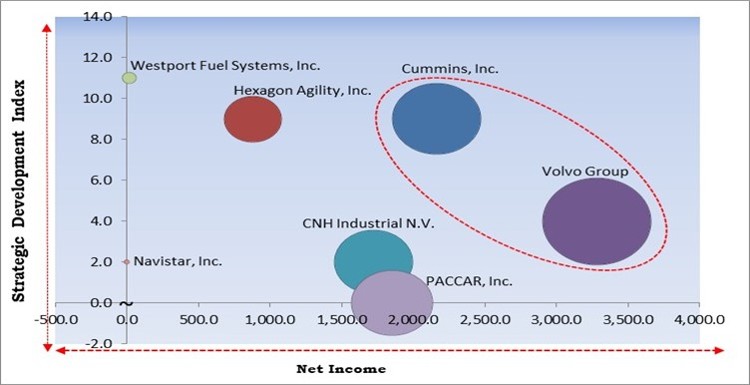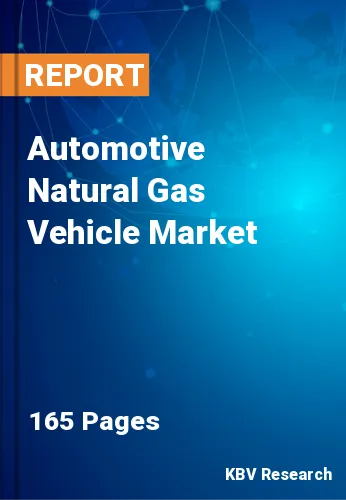The Global Automotive Natural Gas Vehicle Market size is expected to reach $14.3 billion by 2028, rising at a market growth of 5.9% CAGR during the forecast period.
Automotive natural gas vehicles use an alternative to diesel and gasoline, liquefied natural gas (LNG), or compressed natural gas (CNG). Buses, lift trucks, light and heavy vehicles, motorbikes, automobiles, vans, and locomotives make extensive use of natural gas. Natural gas is a more inexpensive and environmentally beneficial alternative to conventional fuels. Nowadays the penetration of automotive natural gas cars is rising due to their operating advantages. The increasing need for alternative fuels in the transportation field is prompting industry participants to use LNG for their operations. Consequently, the transportation industry is experiencing an increase in the requirement for LNG vehicles.

Natural gas vehicles function similarly to gasoline-powered automobiles. Typically, a natural gas vehicle's fuel tank or cylinder is located near the rear of the vehicle. Using fuel lines high-pressure gas is transferred from the gas tank by the fuel system to the combustion chamber. The fuel is then mixed with air inside the combustion chamber, where it is compressed and ignited with the help of a spark plug. It has been observed that vehicles powered by natural gas have low emissions and high performance.
Prominently, three varieties of NGVs exist namely, dedicated, dual-fuel, and bi-fuels. Dedicated vehicles are exclusively built to operate on natural gas. Bi-fuel vehicles are equipped with two distinct fueling systems that allow them to operate on either gasoline or natural gas. The dual-fuel systems vehicles run on natural gas, while diesel fuel is used to assist the ignition. Traditionally, this design is exclusive to heavy-duty trucks. Under pressure, CNG vehicles retain natural gas in containers where it stays in a gaseous state. Because LNG is kept as a liquid, its energy density is larger than that of CNG, allowing more fuel to be carried onboard a vehicle utilizing LNG. This makes LNG suitable for Class 7 and 8 trucks that require a longer range. Frequently, the choice of fuel is dictated by vehicle application requirements (e.g., energy requirements) and desired driving range.
The global economy suffered a significant setback because of the COVID-19 pandemic, which had a detrimental influence on automobile production. The pandemic caused political, social, and economic disruptions in important industries, which impeded growth to some degree. Several production facilities ceased operations as a consequence of the pandemic's effects on the supply chain. The outbreak had a severe influence on the sales of commercial and passenger vehicles, which in turn damaged the requirement for NGVs in the automotive industry. However, post-pandemic, a number of firms have reported an increase in sales of natural gas-powered vehicles, which is anticipated to propel the expansion of the automotive natural gas vehicle market throughout the forecast period.
As many nations have become more worried about rising emissions, the spread of vehicles powered by low-emission fuels, such as CNG and LNG, may accelerate. Numerous nations have expressed a goal to reduce pollutants over the next few years, and they are enacting stricter regulations for these vehicles in the coming years. Many nations have already supported the development of alternative fuel vehicles like CNG and LNG in an effort to reduce gasoline import-related emissions and costs. Current automobiles can be easily and affordably converted to LNG or CNG fuel systems.
The sale of CNG and LNG automobiles as a less expensive alternative to gasoline/diesel vehicles has expanded dramatically in a number of automotive categories across the nation. Multiple times as many CNG-powered vehicles have been registered in recent years. In addition, the number of gasoline/CNG vehicle registration has also increased. Also, a substantial number of gasoline/hybrid vehicles are being produced to meet the expanding demand of the concerned populace.
Changes in climate are occurring all around the planet. Countries around the world are taking steps to limit their emissions of greenhouse gases including carbon dioxide. Several nations throughout the world are embracing electric vehicles in order to reach their net-zero emission goals, which is growing the global demand for electric vehicles. Unlike conventional gasoline-powered vehicles, electric vehicles run on renewable power and produce no emissions. Eliminating the need for any other sort of engine, an electric vehicle features an electric motor that operates on battery-supplied electric power.

On the basis of vehicle type, the automotive natural gas vehicle market is divided into passenger vehicles, light-duty & heavy-duty buses and trucks, and three-wheelers. The light-duty and heavy-duty segments recorded a substantial revenue share in the automotive natural gas vehicle market in 2021. Light-duty NGVs are automobiles that run on propane, LPG, compressed natural gas, or other compressed fuels. Growth is predicted to be fueled by rising clean fuel demand as well as growing worries about the negative effects of utilizing petroleum goods.
Based on fuel type, the automotive natural gas vehicle market is categorized into CNG and LNG. The CNG segment garnered the highest revenue share in the automotive natural gas vehicle market in 2021. The expansion of this segment can be ascribed to the growing number of government efforts aimed at reducing vehicle emissions and enhancing environmental protection. The non-toxicity of CNG reduces its environmental impact.
| Report Attribute | Details |
|---|---|
| Market size value in 2021 | USD 9.8 Billion |
| Market size forecast in 2028 | USD 14.3 Billion |
| Base Year | 2021 |
| Historical Period | 2018 to 2020 |
| Forecast Period | 2022 to 2028 |
| Revenue Growth Rate | CAGR of 5.9% from 2022 to 2028 |
| Number of Pages | 165 |
| Number of Tables | 253 |
| Report coverage | Market Trends, Revenue Estimation and Forecast, Segmentation Analysis, Regional and Country Breakdown, Competitive Landscape, Companies Strategic Developments, Company Profiling |
| Segments covered | Vehicle Type, Fuel Type, Region |
| Country scope | US, Canada, Mexico, Germany, UK, France, Russia, Spain, Italy, China, Japan, India, South Korea, Singapore, Malaysia, Brazil, Argentina, UAE, Saudi Arabia, South Africa, Nigeria |
| Growth Drivers |
|
| Restraints |
|
Based on region, the automotive natural gas vehicle market is analyzed across North America, Europe, Asia Pacific, and LAMEA. The Asia Pacific segment procured the maximum revenue share in the automotive natural gas vehicle market in 2021. This expansion is attributable to increased passenger car production and sales in the region. Due to the growth of natural gas facilities in nations like India, China, and Pakistan, this area is the biggest adopter of natural gas vehicles. In India, for instance, the City Gas Distribution (CGD) policy was developed by the Ministry of Petroleum and Natural Gas. In accordance with the policy, the state would extend CNG infrastructure nationwide.
Free Valuable Insights: Global Automotive Natural Gas Vehicle Market size to reach USD 14.3 Billion by 2028

The major strategies followed by the market participants are Product Launches. Based on the Analysis presented in the Cardinal matrix; Cummins, Inc. and Volvo Group are the forerunners in the Automotive Natural Gas Vehicle Market. Companies such as Westport Fuel Systems, Inc., Hexagon Agility, Inc., CNH Industrial N.V. are some of the key innovators in Automotive Natural Gas Vehicle Market.
The market research report covers the analysis of key stake holders of the market. Key companies profiled in the report include Volvo Group, CNH Industrial N.V., Cummins, Inc., Hexagon Agility, Inc. (Hexagon AB), Beijing Foton International Trade Co., Ltd., Clean Energy Fuels Corp., PACCAR, Inc., Navistar, Inc., Quantum Fuel Systems LLC and Westport Fuel Systems, Inc.
By Vehicle Type
By Fuel Type
By Geography
The global Automotive Natural Gas Vehicle Market size is expected to reach $14.3 billion by 2028.
Nations face a growing need for vehicles that emit fewer pollutants are driving the market in coming years, however, Increase in electric vehicle demand restraints the growth of the market.
Volvo Group, CNH Industrial N.V., Cummins, Inc., Hexagon Agility, Inc. (Hexagon AB), Beijing Foton International Trade Co., Ltd., Clean Energy Fuels Corp., PACCAR, Inc., Navistar, Inc., Quantum Fuel Systems LLC and Westport Fuel Systems, Inc.
The expected CAGR of the Automotive Natural Gas Vehicle Market is 5.9% from 2022 to 2028.
The Passenger Vehicles market is leading the segment in the Global Automotive Natural Gas Vehicle Market by Vehicle Type in 2021; thereby, achieving a market value of $9.2 billion by 2028.
The Asia Pacific market dominated the Global Automotive Natural Gas Vehicle Market by Region in 2021; thereby, achieving a market value of $7.0 billion by 2028.
Our team of dedicated experts can provide you with attractive expansion opportunities for your business.

